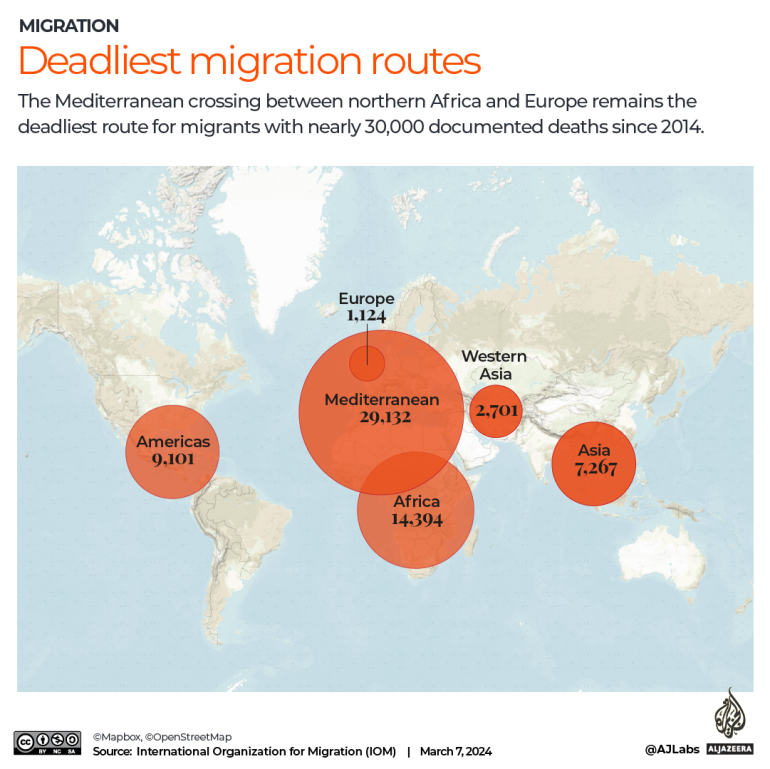The International Organization for Migration (IOM) says 2023 was the deadliest year on record for refugees and migrants, with at least 8,565 people dying on migration routes across the world.
This is a 20 percent rise from the previous year.
The previous record was 8,064 deaths in 2016. At the time, there was a surge of refugee deaths in the Mediterranean because of the numbers of people trying to escape conflict zones, including Syria, Afghanistan and Iraq. Many refugees fleeing conflict zones have tried to reach European countries for safety.
How and where did refugees and migrants die?
At least 8,565 refugees and migrants died last year, more than half by drowning during sea voyages in the Mediterranean. Nine percent were caused by vehicle accidents and 7 percent by violence. The second-highest number of migrant deaths after 2016 at 7,141 was in 2022, with 2020 recording the lowest number of migrant deaths at 4,032.
In December, 61 refugees and asylum seekers died in a shipwreck off the coast of Libya while at least 25 people drowned in a shipwreck off the coast of Tunisia in April.
At least 3,129 deaths and disappearances have been recorded in the Mediterranean since 2017, making it the deadliest route for refugees. In Africa, 1,866 deaths occurred mainly in the Sahara Desert and on the sea route to the Canary Islands. In Asia, 2,138 deaths were reported, mostly of Afghan and Rohingya refugees attempting to flee violence and conflict in their countries of origin.

What has changed in the last year?
The rise in deaths of migrants and refugees comes at a time when their rights are increasingly under attack from countries they hope to reach and in nations where they hope to make new homes.
In some countries, refugees are being expelled. In the Netherlands, for example, thousands of third-country nationals, mostly students and young workers from Asia and Africa, who had fled Russia’s invasion of Ukraine, have been told to leave the country.
Many countries are restricting legal routes for refugees to enter, meaning they have little choice but to undertake even more dangerous journeys to reach safety.
In the United Kingdom, for example, there is no visa route for refugees to travel to the UK. The Refugee Council this week said refugee resettlements in the UK had plummeted to a 10-year low of 766 for the whole of 2023 as a result of the restrictions on legal routes to safety.
European countries are also teaming up with “departure countries” to restrict refugees and migrants. Last year, the European Union signed a 10-million-euro ($11m) deal with Tunisia, where many attempt sea crossings across the Mediterranean, to crack down on undocumented people trying to get to Europe.
Meanwhile, conditions for refugees and asylum seekers are becoming intolerable in many places, forcing people to move on again. This week, Human Rights Watch reported that Malaysia is holding thousands of refugees and migrants in a network of “violent, squalid” detention centres in which they are deprived of basic necessities and can be subject to torture.
Who are the refugees and migrants?
IOM has been tracking deaths and disappearances through the Missing Migrants Project since 2014.
Over the years, it has found that about 13 percent of the total number of refugees and migrants are children under the age of 18 while 48 percent are women and girls.
Many are victims of human trafficking. From 2002 to 2021, the Counter Trafficking Data Collaborative (CTDC) said 156,330 individual cases of trafficking had been reported.
Many refugees are victims of natural disasters. In 2022, more than 30 million people were internally displaced – forced to flee to another area of their own country – because of natural disasters, such as flooding or earthquakes, according to figures from the Internal Displacement Monitoring Centre (IDMC).
As of 2023, a total of 114 million people have been forced to flee their home countries due to persecution, human rights violations, violence, armed conflict and serious public disorder, according to the Office of the United Nations High Commissioner for Refugees (UNHCR).
However, “most people who are forced to flee never cross an international border, remaining displaced within their own countries,” said Shabia Mantoo, a UNHCR spokesperson. “As for refugees [those who cross international borders in search of safety], most stay in countries neighbouring or close to their countries of origin.”
What is the difference between migrants, asylum seekers and refugees?
- Migrants are people who travel from one location to another to change their residence on either a temporary or permanent basis for any reason. This can be within their native countries or outside of them. There is no formal legal definition of a migrant.
- Refugees are people who have fled their countries of origin “for reasons of feared persecution, conflict, generalised violence, or other circumstances that have seriously disturbed public order and, as a result, require international protection”, according to the UNHCR. This definition was determined by the Refugee Convention of 1951.
- Asylum seekers are people who have fled their native countries because of persecution, violence or conflict and are seeking international protection. Their status as refugees has not yet been determined. Asylum seekers may be granted the status of refugees in the countries they flee to, but not all will.

